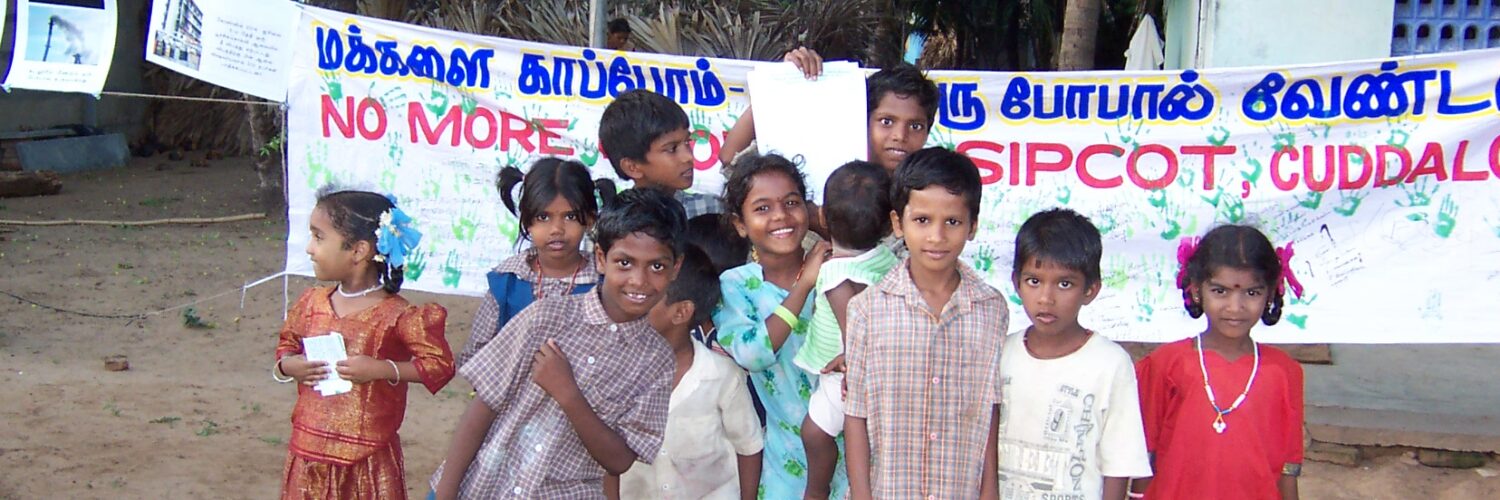SIPCOT Area Community Environmental Monitors
C/o 27 Abdul Khader Street, Manjakuppam, Cuddalore 607 001
SIPCOT air remains dangerously polluted, New Bucket sample shows
PRESS RELEASE
Cuddalore 17 December 2004: SIPCOT air remains dangerously polluted despite Supreme Court Monitoring Committees (SCMC) order directing the TN PCB to clean up the industries or shut down violators after December 31, according to results of a new scientific study. A bucket sample taken downwind of Tantech Agro Chemicals by SIPCOT Area Community Environmental Monitors (SACEM) on 30 October, 2004, contained eight volatile organic and sulphur compounds, including chemicals that are known to cause cancer in animals. SACEM reported a gas leak at Tantech between 8 and 9 p.m. on 30 October. Eachangadu residents said they experienced a strong odour of burning mosquito coil and ammonia, and many suffered from severe headache, and throat and skin irritation.
The air in the residential area behind Tantech near Eachangadu village was found to contain carbon disulphide, bromomethane, trichloroethene, 4-methyl 2-pentanone, isopropyl alcohol, acetone, 2-butanone and toluene. Trichloroethene and Bromomethane cause cancers of lung, kidney, stomach and liver in animals. All 8 chemicals cause one or more of the symptoms reported, namely headache, and skin and throat irritation. Four chemicals exceeded USEPA standards for ambient air quality. Trichlorethene a chemical that targets heart, liver, kidneys and the respiratory system was found at more than 418 times above USEPA levels.
The sample was taken barely 15 days after a Central Pollution Control Board team from Bangalore conducted a three-day air sampling following up on SCMCs directions. Because the CPCB
sampling was conducted in cooperation with the industry, none of the industries were functioning normally on the days of sampling. SACEM conduced 5 pollution patrols of SIPCOT to assess the intensity of odour between 12 October and 13 October, 2004. Four out of five patrols reported “no odour” and “factories not operating.” The odour resumed and was reported to be “mild but noticeable” during the pollution patrol on 13 October at around 8 p.m. Reports of the patrol were communicated to the TNPCB.
At least 7 serious violations of environmental regulations were documented by SACEM, of which 6 were reported to the TNPCB. On 4 October, fishermen reported an oily layer and black effluents in Uppanar near Victory Chemicals. On 14 and 15 October, fisher folk sustained skin injuries after entering the Uppanar near Kudikadu. On 29 October, a toxic gas leak that smelled of rotten eggs — reportedly from SPIC Mitocon caused severe headache and nausea among numerous Eachangadu residents. On December 3, Victory Chemicals dumped 100 lorry loads of toxic wastes in Cuddalore New Town.
The TNPCB has been more responsive than in the past to complaints. However, it has sought to downplay the problems reported without presenting any scientific evidence. Eachangadu villagers complaints of nausea, vomiting and headache after exposure to toxic gas reportedly from SPIC Mitocon on 29 October were dismissed by the TNPCB engineer as “mass hysteria.”
“The Pollution Control Board needs to trust people more, and realise that they are there to protect the people, not the industries. Currently, it is friendly with the industry and sees people as enemies or troublemakers. This attitude has to change if pollution is to be brought under control,” SACEM said.
SACEM has demanded that:
- the CPCB should involve SACEM in monitoring the pollution;
- the Government should abandon plans of setting up new hazardous units such as Pandian Chemicals in SIPCOT;
- the Pollution Control Board should use science as a basis for its explanations on pollution incidents to villagers;
For more information, contact:
M. Nizamudeen. Cell: 9443231978
